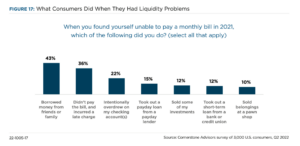Overdraft is Now a Buzzword that Masks the Real Industry Issue: Consumer Liquidity
Joel Schwartz, Co-CEO of DoubleCheck Solutions and Christopher Leonard, CEO of Velocity Solutions
A Google search on the term “overdraft” returns more than 69 million results, many of which focus on how to avoid “unfair” fees. However, the negative press and regulatory chagrin over overdraft fees doesn’t reflect the reality that most American consumers value and understand this service. Studies have shown that responsibly-run overdraft programs provide benefits to consumers that are many times the amount of the overdraft fee, and a recent Morning Consult survey found that half of Americans think overdraft fees are fair.
The narrative pushed by regulators and neobanks trying to compete with more traditional financial institutions has focused on the dollar amount of the fee. But what they’re not talking about is how the concept of “you get what you pay for” applies in this situation. Meaning, what about the dollar amount of the liquidity that the financial institution provides to the consumer? And what kind of say can the consumer have in how their payments are handled?
These are extremely important distinctions that distract us from having a conversation about the most important piece of the overdraft puzzle: the need for consumer liquidity with transparency and control.
Closing the consumer liquidity gap with flexibility and control
This need is remarkably high right now. A Lending Club/Pymnts.com survey found that 61% of consumers reported living paycheck to paycheck. Half of U.S. hourly workers have absolutely no emergency savings. And Cornerstone Advisors’ recent survey found that roughly a quarter of Gen Zers and Millennials spent more money than they had in their checking accounts three or more times a year.
Overdraft programs can certainly provide better service by focusing more on the need for consumer liquidity, flexibility, and control and less on the semantics around fees. Most important is to set everyone up for success by establishing an overdraft limit that is not more than the consumer can repay. Velocity Solutions recommends underwriting the limits at least monthly at the account level. Financial institutions should then take this one step further by monitoring situations where people are paying a disproportionate share of their income in overdraft fees—and addressing these situations so they do not continue. The onus is on the institution to leverage the data they collect for the consumer good.
But even that’s not enough. In addition to customizing liquidity options by consumer, financial institutions should give them flexibility and control over how and when they choose to use overdraft services. Again, this is all about addressing the consumers’ need for liquidity through a valuable service. If they’re aware of their account shortage before they go to the store, or they’re given the choice on which charge to return when they do face a shortage, they’re in charge of the choices they make. They can choose to not make the purchase, of course, but they can also choose how to address their liquidity shortage if it’s necessary.
The Cornerstone Advisors survey showed that when faced with a liquidity challenge, most consumers either borrowed money from friends or family or didn’t pay the bill—incurring a late charge. If faced with the same challenge next month, they’d pay the expense with a credit

card and carry a balance or keep borrowing from friends and family. DoubleCheck’s Solution gives them these options right from their bank or credit union’s website, without the risk of extra fees from the payee or payor. When faced with a shortage, consumers are notified and given 24 hours to pay via overdraft, credit card, cash deposit at a branch, responsible small-dollar short-term loan, or third-party payment service such as Zelle. The solution goes beyond overdraft to provide consumers with the choice to select the liquidity option that meets their needs.
The bottom line: a “one size fits all” approach to overdraft solutions no longer works for consumers or regulators. Overdraft fees are currently subsidizing the costs of “free” checking accounts—so, those consumers who can afford overdraft services are subsidizing others who cannot afford the service. But, eliminating overdrafts altogether puts the target more on the underbanked and unbanked—many would be kicked out of mainstream banking without the service because they wouldn’t be able to afford monthly account fees imposed when the overdraft subsidy goes away, and wouldn’t have a liquidity solution either (according to a 2021 paper from the Federal Reserve Bank of New York).
Envision a better overdraft
Overdraft meets a need and a critical service. But we can do better. Picking a general, arbitrary overdraft limit doesn’t meet consumer needs, and it’s not going to satisfy regulators any longer. Financial institutions can provide solutions like overdraft allowance with the highest level of transparency and control. We’re working with customers to do this every day.
First, set managed, customized limits based on consumers’ ability to repay. You can do this by looking at their transactional behavior: Velocity Solutions can use transaction data to underwrite an overdraft limit at the account level for you. Then, be transparent about their account status and give them choices for how to repay their account—using a solution like DoubleCheck’s to add transparency and control to the process. Since fraud can sometimes be a factor, this solution also enables consumers to take timely action to report and rectify it before it leads to issues. This solution also adds benefits to the financial institution from a compliance perspective, as it provides disclosures, acknowledgements and other communications your customers need and deserve plus audit trails and reporting.
Technology enables us to do better, and it’s not only our prerogative as financial institutions to use it to provide a better experience to our consumers—it’s our responsibility and obligation. DoubleCheck and Velocity Solutions are proud to be partners in helping financial institutions fulfill these duties. For more information, simply complete the form below to contact either Joel Schwartz or Christopher Leonard.
 About Joel Schwartz
About Joel Schwartz
Joel Schwartz is the Founder & Co-Chief Executive Officer of DoubleCheck Solutions, a financial technology company with an innovative solution that delivers new revenue for Financial Institutions while giving customers and small businesses more transparency and control in the event of Non-Sufficient Funds (NSF). www.mydoublecheck.com
 About Christopher Leonard
About Christopher Leonard
Christopher Leonard is CEO of Velocity Solutions, a financial technology company that provides software to financial institutions to improve revenue and manage risk. Prior to becoming CEO, Christopher served as President of the company from 2012 to 2014, and Chief Operating Officer & General Counsel from 2005 to 2011. www.myvelocity.com